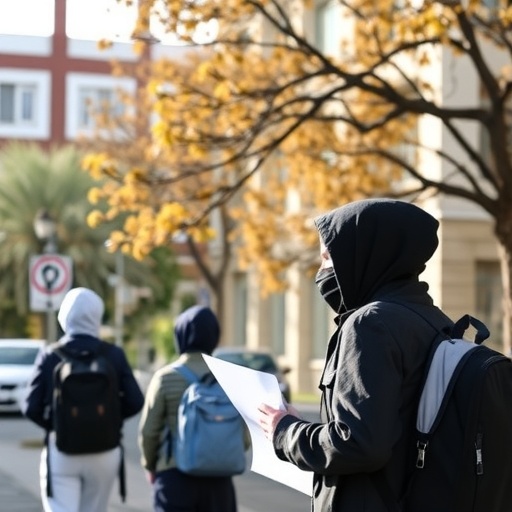
In the densely crowded urban landscape of Taipei City, a new beacon of hope is emerging for victims of out-of-hospital cardiac arrest (OHCA). An innovative simulation study conducted by a team of Taiwanese researchers has explored a radical approach: leveraging the ubiquitous presence of food delivery riders to expedite defibrillator delivery. In a city where every second counts, this novel strategy holds immense promise to dramatically improve survival rates by reducing response times to nearly half that of traditional emergency medical services (EMS).
Cardiac arrest survival hinges critically on rapid defibrillation. It is well established that every minute delay in delivering an automated external defibrillator (AED) decreases survival probabilities by an estimated 7 to 10 percent. Despite this urgency, the reality in densely populated urban centers is that EMS response times are often constrained by traffic congestion, logistical hurdles, and resource limitations. This challenge motivated lead investigator Kuan-Chen Chin and colleagues to rethink conventional paradigms by tapping into an existing, highly mobile urban workforce—food delivery (FD) riders.
Taipei’s food delivery ecosystem is vast and dynamic, with scooter riders peppering the cityscape and crisscrossing neighborhoods at all hours, especially in congested commercial districts. By integrating this fleet into the community emergency response framework, the researchers hypothesized that these riders could serve as rapid responders equipped with AEDs, thereby facilitating defibrillator delivery far faster than waiting for EMS arrival. To test this, the team conducted a comprehensive city-scale simulation, utilizing real-world OHCA incidence data, actual AED locations, and granular food delivery patterns sourced from Uber Eats.
This experimental simulation rigorously modeled scenarios assuming that each open restaurant in identified urban hotspots had one FD rider on standby, ready to divert to a cardiac arrest incident within a two-kilometer radius. Variable response rates of these riders were analyzed to simulate defibrillator arrival times and compared to the standard documented fire department response time of six to seven minutes. The simulation also accounted for fluctuating activity levels during peak versus off-peak hours, illuminating how rider availability and density influenced effectiveness.
The results were nothing short of remarkable. Even with a modest 10 percent FD rider response rate, the delivery time of AEDs was reduced by an average of 2.99 minutes—a near 44 to 50 percent decrease compared to EMS. This time saving could mean the difference between life and death for countless patients. Notably, in the simulation, more than 60 percent of OHCAs were reached successfully by FD riders deploying AEDs. Moreover, achieving 80 percent coverage during high-demand peak hours required just a 13.4 percent response rate of riders, underscoring the scalability and practicality of the approach during busy periods.
The technical underpinnings of this study lie in its multi-source data integration and robust modeling. Utilizing the Taipei City Fire Department’s Registry of OHCA cases from 2017 to 2019 provided an empirical backbone. Geospatial mapping of AED locations was cross-referenced with Uber Eats food delivery hotspots, allowing the simulation to allocate real-time rider availability with realistic spatial distribution. This intersection enabled an accurate replication of emergency scenarios, rider dispatch probabilities, and travel logistics. The model smartly incorporated stochastic elements to reflect rider response variability and traffic conditions, yielding credible and actionable insights.
Co-corresponding investigator Albert Y. Chen highlighted the transformative potential of this strategy, emphasizing that incorporating FD riders into EMS frameworks can substantially reduce AED arrival latency, especially when time-critical cardiac events surge during peak urban activity. Additionally, co-investigator Jen-Tang Sun underscored that even lower response rates during off-peak hours could still produce meaningful improvements in AED response times, illustrating robustness under variable resource availability.
This paradigm shift in community emergency response is not just innovative but also cost-effective and scalable. Unlike deploying new resources or heavily investing in specialized rapid response units, repurposing existing food delivery riders leverages a distributed network that is already funded and operational. The model promotes a symbiotic relationship between commercial delivery services and public health outcomes, potentially transforming citywide cardiac arrest survival strategies without incurring prohibitive costs or infrastructural overhauls.
Critically, the study also sheds light on urban design and public health planning intersections. The densification of cities, often viewed as a challenge for EMS due to traffic and accessibility constraints, can conversely be harnessed as an asset when a widespread mobile workforce is strategically mobilized. In addition to reducing response times, this approach may increase the rate of bystander AED use, as FD riders could provide on-the-ground assistance and potentially improve post-arrest care coordination.
More broadly, this research opens avenues for integrating non-traditional responders into emergency medical systems worldwide, particularly in other metropolitan centers with bustling food delivery economies. As urban populations swell and cardiac emergencies mount, conventional EMS systems may increasingly face pressure. Innovative, data-driven, and technology-enabled solutions like this simulation-driven model demonstrate a forward path to resilience and enhanced health outcomes.
Future work will likely focus on real-world pilot programs, validating simulation findings with live dispatch data, and addressing logistical barriers such as rider training, AED carriage safety, legal frameworks, and public awareness. Additionally, leveraging GPS tracking, app-based coordination between EMS dispatch centers and FD riders, and real-time traffic data integration will be critical to optimize deployment and ensure reliability.
In conclusion, this pioneering simulation study from Taipei charts an exciting course to revolutionize defibrillator delivery in dense urban environments. By embracing the agility and ubiquity of food delivery riders as first responders equipped with AEDs, cities can drastically cut response times, improve cardiac arrest survival rates, and redefining community-based chains of survival. This innovative intersection of urban mobility and emergency healthcare offers a compelling model with potential global implications, underscoring that sometimes, lifesaving help could already be just around the corner on a delivery scooter.
Subject of Research: People
Article Title: Enhancing the Community Chain of Survival: A Simulation Study of Defibrillator Delivery by Food Delivery Riders in a High-Density City
News Publication Date: 28-Aug-2025
Web References: http://dx.doi.org/10.1016/j.cjca.2025.07.017
References: Canadian Journal of Cardiology, Elsevier, 2025
Keywords: Out-of-Hospital Cardiac Arrest, Automated External Defibrillator, Food Delivery Riders, Emergency Medical Services, Urban Health, Simulation Study, Defibrillator Delivery, Response Time Reduction, Taipei City, EMS Integration, Public Health Innovation, High-Density Urban Emergency Response
Tags: cardiac arrest response strategiescommunity-based emergency response systemsdefibrillator delivery innovationemergency medical services challengesfood delivery riders as first respondersfood delivery services for emergency responseimproving survival rates in cardiac arrestleveraging urban mobility for healthout-of-hospital cardiac arrest solutionsrapid defibrillation in urban areasTaipei City healthcare initiativesurban health innovation in Taiwan




